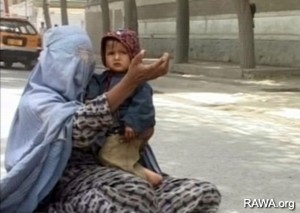IRIN News, June 12, 2008
AFGHANISTAN: Over 3.5 million at 'high risk' of food insecurity - ministry
“High prices, drought and conflict are three major causes of the worsening food-insecurity,” Safi said.
High food prices and drought have driven over one million vulnerable people across Afghanistan into “high-risk” food-insecurity in the past five months, increasing the total number of “most vulnerable people” to over 3.5 million, the Ministry of Agriculture, Irrigation and Livestock (MAIL), told IRIN.

"We estimate that now over 3.5 million people are seriously food-insecure."
A joint vulnerability assessment conducted by UN agencies and Afghan governmental bodies in December 2007 identified 2.55 million Afghans (out of a total population of some 26 million) as being in need of an emergency “safety net” and severely affected by high food prices.
Since January, food has become unaffordable for thousands of vulnerable households. Afghanistan was ranked the fifth least developed country in the world in 2007.
“We estimate that now over 3.5 million people are seriously food-insecure and in need of a safety net,” said Saduddin Safi, head of the department of food-security at the MAIL.
“High prices, drought and conflict are three major causes of the worsening food-insecurity,” Safi said.
Governors issue warning
Meanwhile, the governors of four northeastern provinces affected by drought - Kunduz, Baghlan, Takhar and Badakhshan - have warned about a possible “humanitarian catastrophe” if the food needs of their people are unmet.
The governors, who met on 10 June in Kunduz Province, said tens of thousands of poor households in their provinces were increasingly facing food-insecurity mostly due to drought and rising prices.
The Afghan government and aid agencies are currently working to assess the magnitude of the food crisis, and launch a new aid appeal to assist most affected households.
Aid distribution
In January the UN World Food Programme (WFP) agreed to distribute 88,000 tonnes of mixed food aid (wheat, pulses, iodised salt and vegetable oil) for 2.55 million highly food-insecure Afghans until June 2008.
According to The Joint Appeal for the Humanitarian Consequences of the Rise in Food Prices every eligible household should receive 240kg of mixed food aid in three distribution rounds.
However, only about 31 percent (28,000 tonnes) of the planned aid has been distributed so far. Afghan officials are suggesting WFP change its modes of distribution to better help those affected.
“Instead of food aid given to one family in three rounds we propose that these families be assisted in one go,” Safi said, adding that such a change would also cover households pushed into extreme vulnerability after the aid appeal of January 2008.
In at least one instance distribution had been cancelled because people had been frustrated after seeing aid go to some but not others, he said.
“Needs are high and so are expectations… The number of needy people has risen sharply in the past six months and this complicates aid distribution [where it is] only to those who were surveyed and identified last year,” said Safi.
WFP representative Rick Corsino said it may be possible to adjust beneficiary selection criteria: “WFP is willing to consider somewhat revised criteria, providing they can be justified and substantiated, and that the contributing donors also agree.”
Debate over modes of aid distribution
MAIL’s Safi said it would make more sense in cases of free distribution for the 240kg of aid to be distributed in one go, rather than in three rounds. “This would reduce logistical and operational costs and ensure beneficiaries have uninterrupted access to aid,” he said.
Fewer distributions could also reduce security risks: In the past 18 months 40 WFP-contracted food trucks have been attacked, resulting in the loss of 1,000 tonnes of food.
WFP’s Corsino, however, pointed to logistical problems: “This is not practical as the food arrives in Afghanistan progressively over a number of months. We believe it is better to give all intended beneficiaries some of the allocation as quickly as possible, rather than giving some [people] all of their allocation at the start, and giving others all of their allocation [only] months later when the last shipments arrive.”
A big proportion of emergency food aid is planned to take place within food-for-work projects, WFP said. Free distribution is also part of the programme, but only to the most vulnerable families, such as households headed by women or the disabled.
Characters Count: 5339
